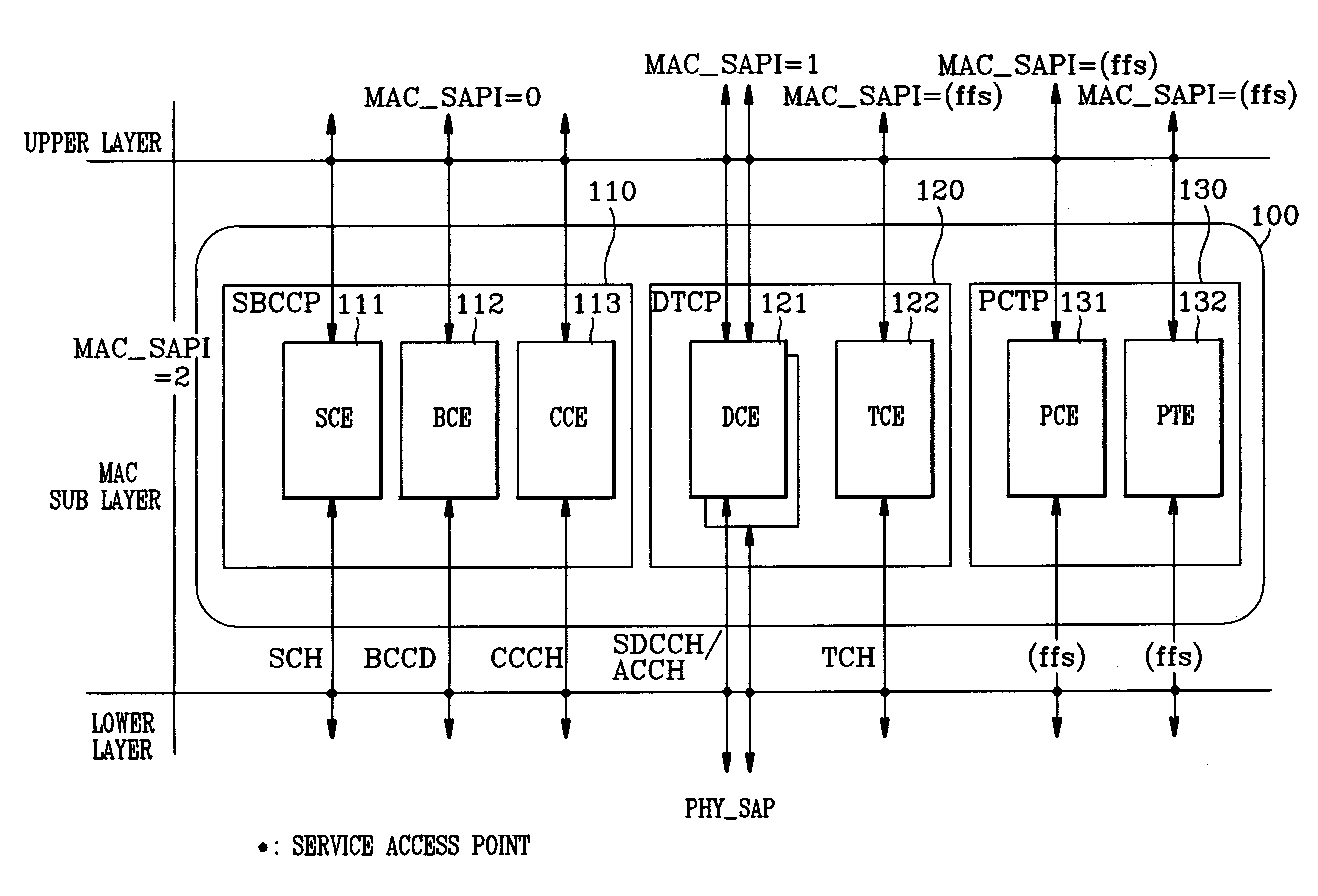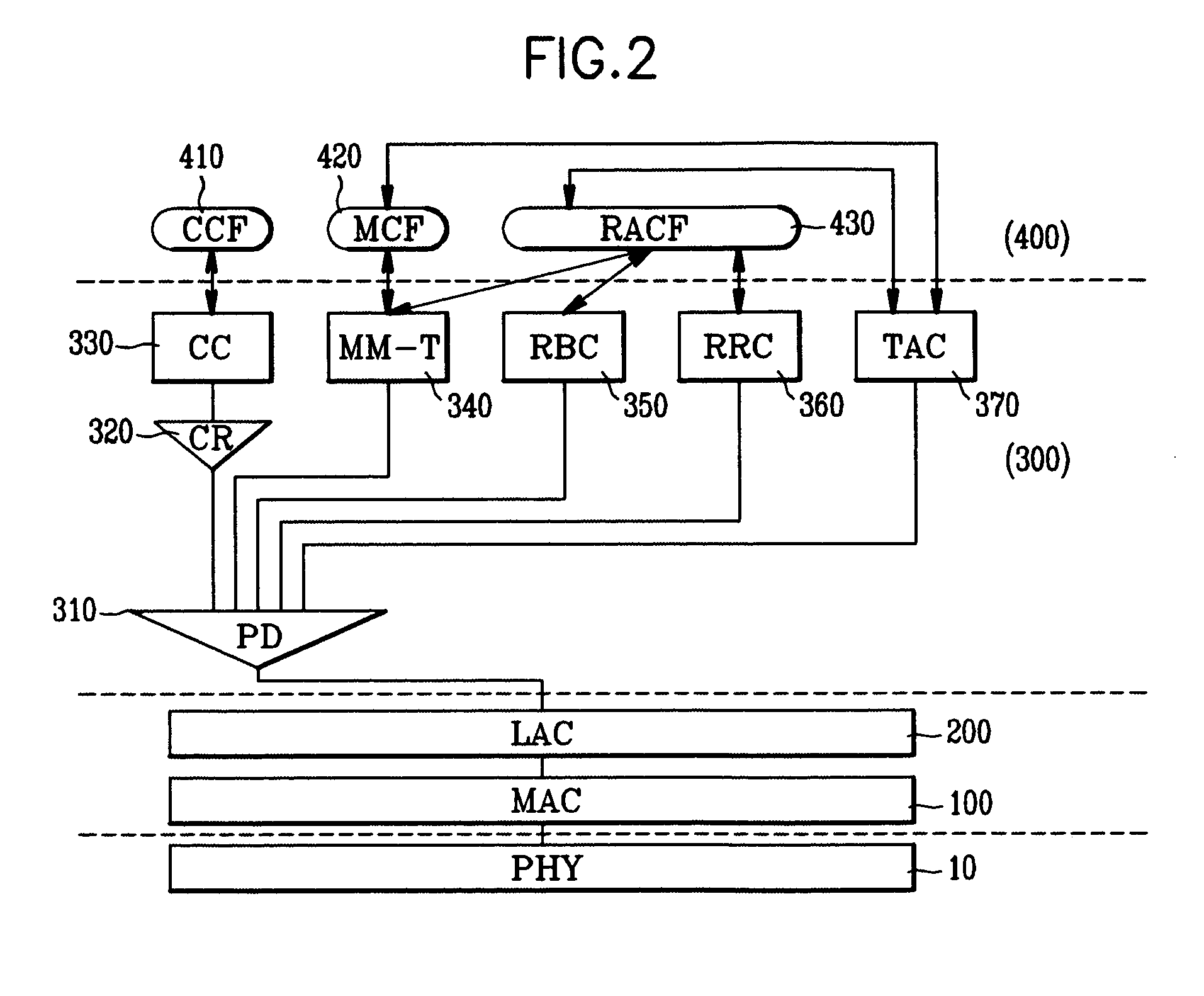Communication system with improved medium access control sub-layer
a communication system and control sub-layer technology, applied in the field of communication systems with medium access, can solve problems such as weakening the competitiveness of communication products
- Summary
- Abstract
- Description
- Claims
- Application Information
AI Technical Summary
Benefits of technology
Problems solved by technology
Method used
Image
Examples
first embodiment
[0037]FIG. 2 is a block diagram of a protocol stack provided in each terminal or base station in a communication system in accordance with the present invention.
[0038]With reference to FIG. 2, the protocol stack is composed of a physical layer (PHY) 10, a MAC sub-layer 100 which is an upper layer of the PHY 10, a link access control (referred to hereinafter as LAC) sub-layer 200 which is an upper layer of the MAC sub-layer 100, an upper layer 300 of the LAC sub-layer 200, and an application layer 400 which is an upper layer of the layer 300. The upper layer 300 includes a protocol discriminator (PD) 310, call reference (CR) 320, call control (CC) 330, mobility management entity (MM-T) 340, radio bearer control entity (RBC) 350, radio resource control entity (RRC) 360 and terminal association control entity (TAC) 370. The application layer 400 includes a call control function (CCF) 410, mobile control function (MCF) 420 and radio access control function (RACF) 430.
[0039]In the commun...
second embodiment
[0065]A method of processing signals using MAC sub-layers in a communication system in accordance with the present invention will hereinafter be described with reference to FIGS. 6 and 7A to 7J.
[0066]FIG. 6 is a flowchart illustrating an operation of controlling signals between MAC sub-layers of a mobile terminal (MT) and a network (NTWK) (or base station).
[0067]With reference to FIG. 6, first, an upper layer (MM1 RBC1 or RRC1) or application layer of the MT transfers a desired control command in the form of a primitive to a link access control 1(LAC1) of the MT at step ST31. The LAC1 transfers a request message based on the control command from the upper layer or application layer of the MT to a MAC1 of the MT at step ST32. The MAC1 of the MT sends the request message from the LAC1 to a MAC2 of the NTWK sequentially through physical layers (PHY1 and PHY2) of the MT and NTWK at step ST33. Then, the MAC2 transfers the request message from the MAC1 to a LAC2 of the NTWK at step ST34. ...
third embodiment
[0108]FIG. 8 is a flowchart illustrating a method of processing signals using MAC sub-layers in a communication system in accordance with the present invention.
[0109]With reference to FIG. 8, for the provision of a call service between a base station and a mobile terminal through MACs included respectively therein, the mobile terminal has to send a channel request message to the base station through a reverse access channel (RACH). The channel request message is used for the request of a radio resource by the mobile terminal.
[0110]In this connection, the base station receives a message from a specific mobile terminal at step S41 and then checks at step S42 whether the received message is a channel request message through the RACH.
[0111]If it is checked at step S42 that the received message is not the channel request message, the base station provides a service corresponding to the received message at step S43. To the contrary, in the case where the received message is the channel re...
PUM
 Login to View More
Login to View More Abstract
Description
Claims
Application Information
 Login to View More
Login to View More - R&D
- Intellectual Property
- Life Sciences
- Materials
- Tech Scout
- Unparalleled Data Quality
- Higher Quality Content
- 60% Fewer Hallucinations
Browse by: Latest US Patents, China's latest patents, Technical Efficacy Thesaurus, Application Domain, Technology Topic, Popular Technical Reports.
© 2025 PatSnap. All rights reserved.Legal|Privacy policy|Modern Slavery Act Transparency Statement|Sitemap|About US| Contact US: help@patsnap.com



